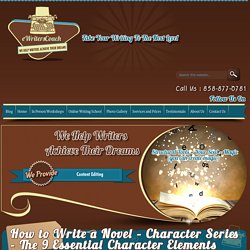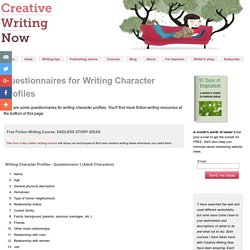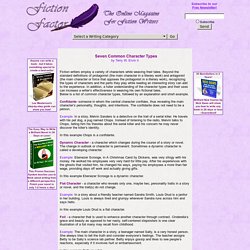

How to Write a Novel – Character Series – The 9 Essential Character Elements Worksheet :eWritersCoach. Welcome to Week 7 of 52 Weeks of 52 Kick Ass Writing Tools!

Today I am going to share my 9 Character Element Worksheet With You Question: What’s the ultimate goal when writing characters? Answer: Writing a character that pops off the page, that is constantly fascinating, and that readers and audiences remember. Oh I got the villain, boy do I got the villain! One writer at a read and critique group I was leading was writing an incredibly boring protagonist.
At first this writer tried the “write to find it” method – this is where he just kept throwing his character into situations hoping that the voice might magically come alive. I decided to look at all the elements that make up a full, real, alive character. Thus this tool was born. By walking the writer through these 9 Elements he was able to swiftly locate the area that was not fully formed in his protagonist (the flaw!). Questionnaires for Writing Character Profiles - Creative Writing Help.
Enter your e-mail to get the e-book for FREE.

We'll also keep you informed about interesting website news. "I have searched the web and used different worksheets, but none have come close to your worksheets and descriptions of (what to do and what not to do). Both courses I have taken have with Creative Writing Now have been amazing. Each time I have learned something new. The one thing I love, you take everything apart and give examples. " - Katlen Skye "As usual - I already love the course on Irresistible Fiction, rewriting a lot and improving greatly even after the first lesson. “Essentials of Fiction proved that I could indeed write and I wrote every day, much to my boyfriend's dismay (waa sniff).” - Jill Gardner "I am loving the course and the peer interaction on the blog is fantastic!!! " "I'm enjoying the weekly email course, Essentials of Poetry Writing. "Thank you for all the material in this course.
"Thanks very much for this course. "I'm learning so much. "Thank you so much!! Welcome to Fuck Yeah Character Development. Character types. Fiction University (The Other Side of the Story) Character Chart. Character Chart for Fiction Writers - EpiGuide.com. If you're a fiction writer -- whether you're working on a novel, short story, screenplay, television series, play, web series, webserial, or blog-based fiction -- your characters should come alive for your reader or audience.
The highly detailed chart below will help writers develop fictional characters who are believable, captivating, and unique. Print this page to complete the form for each main character you create. IMPORTANT: Note that all fields are optional and should be used simply as a guide; character charts should inspire you to think about your character in new ways, rather than constrain your writing. Fill in only as much info as you choose. Have fun getting to know your character! 8 Ways to Write Better Characters. The very first novel I, aged 20-something, wrote, is unpublished and will stay that way.

An ensemble coming-of-age story of four teenagers, its weaknesses are legion: tame story line, thin action, unimaginatively rendered settings, hackneyed themes (though I will say the dialogue wasn’t bad). Having now published seven novels, I look back on that manuscript and realize that underlying the shortcomings I just mentioned lies its principal flaw: poor character development. The kids just don’t pop. So I’ve been pleased to read reviews of my latest novels (the Rita Farmer mysteries) that praise the characterization—and I’ve been struck by the number of them that cite the realism of my characters’ relationships.
While plot is important, good characters can make or break your book. Let’s consider, to start, the categories of relationships we might write in our fiction: … and so many more. Everybody has relationships. Then, explore who they are beyond themselves. Here’s how. 1. 2. 3. 8 Ways to Write Better Characters. 6 Ways to Write Better Bad Guys. Seven Common Character Types. Seven Common Character Types by Terry W.

Ervin II Fiction writers employ a variety of characters while weaving their tales. Beyond the standard definitions of protagonist (the main character in a literary work) and antagonist (the main character or force that opposes the protagonist in a literary work), recognizing the types of characters and the parts they play while reading an interesting story can add to the experience. In addition, a fuller understanding of the character types and their uses can increase a writer’s effectiveness in weaving his own fictional tales. Below is a list of common character types, followed by an explanation and short example. Confidante- someone in whom the central character confides, thus revealing the main character’s personality, thoughts, and intentions. Example: In a story, Melvin Sanders is a detective on the trail of a serial killer. In this example Chops is a confidante. In this example Ebenezer Scrooge is a dynamic character. Copyright © Terry W.